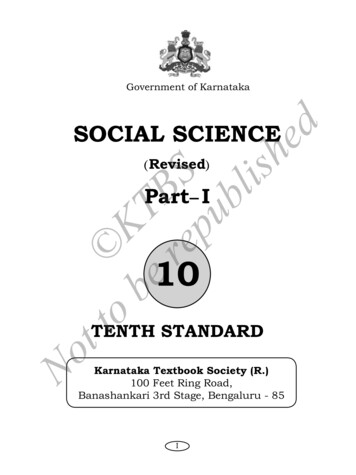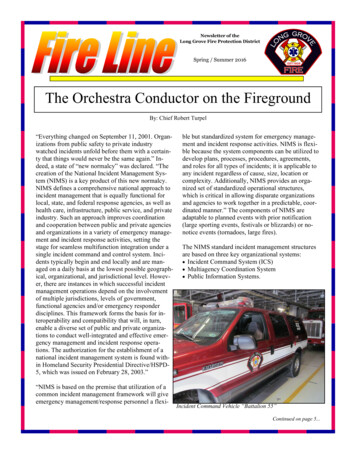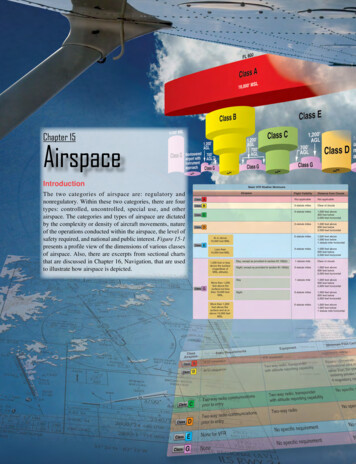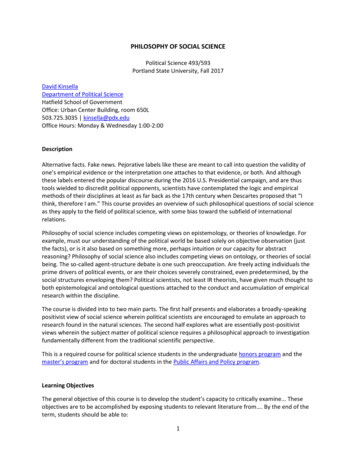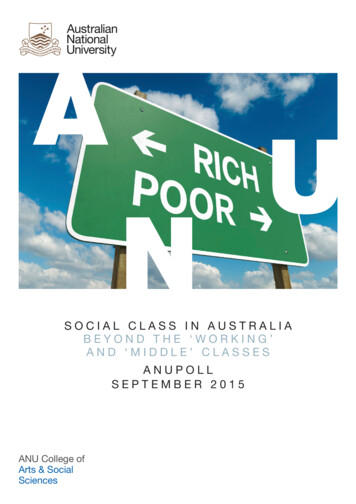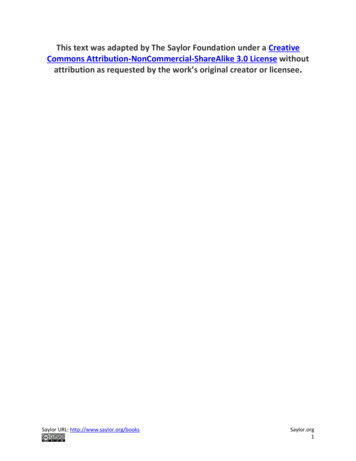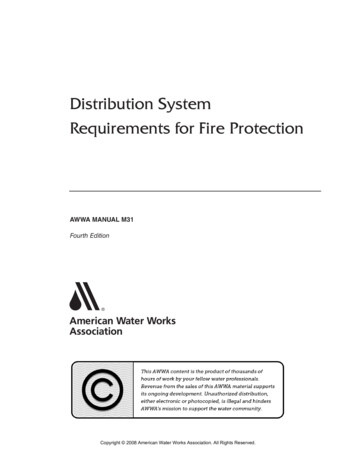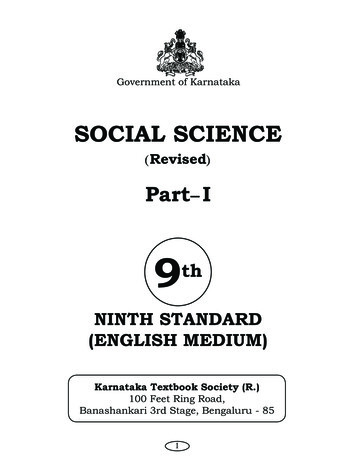
Transcription
Government of KarnatakaSOCIAL SCIENCE(Revised)Part-I9thNINTH STANDARD(ENGLISH MEDIUM)Karnataka Textbook Society (R.)100 Feet Ring Road,Banashankari 3rd Stage, Bengaluru - 85I
PREFACEThe Textbook Society, Karnataka has been engaged in producing new textbooksaccording to the new syllabi which in turn are designed on NCF – 2005 since June2010. Textbooks are prepared in 12 languages; seven of them serve as the media ofinstruction. From standard 1 to 4 there is the EVS, mathematics and 5th to 10th thereare three core subjects namely mathematics, science and social science.NCF – 2005 has a number of special features and they are: connecting knowledge to life activities learning to shift from rote methods enriching the curriculum beyond textbooks learning experiences for the construction of knowledge making examinations flexible and integrating them with classroom experiences caring concerns within the democratic policy of the country making education relevant to the present and future needs. softening the subject boundaries- integrated knowledge and the joy of learning. the child is the constructor of knowledgeThe new books are produced based on three fundamental approaches namely.Constructive approach, Spiral Approach and Integrated approachThe learner is encouraged to think, engage in activities, master skills andcompetencies. The materials presented in these books are integrated with values. Thenew books are not examination oriented in their nature. On the other hand they helpthe learner in the all round development of his/her personality, thus help him/herbecome a healthy member of a healthy society and a productive citizen of this greatcountry, India.In Social science especially in standard 5 the first chapter deals with the historical,geographical, cultural and local study of the division in which learners live. Chapterson sociology, business studies and commerce are introduced in standard VIII as perthe guidelines of NCF-2005. A lot of additional information is given through boxitems. Learners are encouraged to work towards construction of knowledge throughassignments and projects. Learning load of memorizing dates has been reduced to theminimum. Life values have been integrated with content of each chapter.The Textbook Society expresses grateful thanks to the chairpersons, writers,scrutinisers, artists, staff of DIETs and CTEs and the members of the Editorial Boardand printers in helping the Text Book Society in producing these textbooks.Nagendra KumarManaging DirectorKarnataka Textbook SocietyÀBengaluru, KarnatakaProf. G. S. MudambadithayaCoordinator, Curriculum Revisionand Textbook PreparationKarnataka Textbook SocietyBengaluru, KarnatakaII
Chairpersons’ NoteA demand for the change of curriculum, syllabi and textbooks hasbeen heard from parents at every internal of five years. The Governmentof Karnataka has accepted the demand favourably and revised itsCurriculum (KCF 2007) and syllabi in all subjects. As a result of ittextbooks are being prepared in various subjects and the result is thisSocial Science book for standard IX. It has been designed and preparedaccording to the changed situations in various curricular areas to enablethe students to construct knowledge through activities. There are sixsubject areas namely, History, Political Science, Geography, Economics,Sociology and Business Studies.The textbook has been prepared keeping in mind the changing situationsin rural and urban scenario and at the same time providing opportunitiesfor creativity among learners. A large number of activities and projectworks have been designed for the purpose. These are designed based onthe fact that we live in a world of competition where acquiring knowledgehas become the need of the day. The matter has been presented in asimple style and technical words have been glossed. That does not meanthat are have succeeded fully in our endeavour though we have followedthe basic principles enunciated in NCF 2005.We express our grateful thanks to all those who gave us concretesuggestions at every stage of preparation of the book. We are grateful tothe writers, the scrutiny committee members and inatorProf. G S Mudambadithaya who has been striving hard in planning andbringing out textbooks of very high standard in all subjects. We expressour sincere thanks to the Managing Director, Deputy Director and thecoordinator of Social Science book. I also place on record my indebtednessto the Vice Chancellor, Registrar and other colleagues of the University ofTumakuru for their encouragement and guidance.Dr. M. Kotresh,ChairpersonsA.S. DikshitIII
Textbook CommitteeChairpersons :Dr. M. Kotresh, Associate Professor, Department of Studies and Research in History andArchaeology, Tumakuru University, Tumakuru.Sri A.S. Dikshit, Retd. Principal, Vani Education Centre, Basaveshwaranagar, Bengaluru.Members :Dr. Basavaraja N. Akki, Associate Professor, Government First Grade College, Alnavara,Dharwad Tq.Sri N. Satyaprakash, Head Master, Vidyavardhaka Sangha High School, Ist Block, Rajajinagar,Bengaluru - 10.Sri T. Ningaiah, Associate Professor Govt. First grade college, Gubbi, Tumakuru Distrist.Sri B.K. Vasuki, Asst. Master, Vivekananda Trible Residential High School, B.R. Hills,Chamarajanagar District.Sri B. Hanumantharao, Lecturer, Govt. Pre-University College, Chikkaballapura.Sri Kumaraswamy, Principal, Vidyavahini Pre-University College, Tumakuru.Sri S.H. Kurakundi, Drawing Teacher, Government High School, Masanagi, Byadagi Tq.,Haveri District.Scrutinisers :Dr. Rajram Hegde, Professor, Department of History, Kuvempu University, Shankaraghatta,Shivamogga.Prof. T.D. Devegowda, Professor, Department of Political Science, Dean (Study Centeras)K.S.O.U. Mysuru.Dr. Shoukath Azem, Professor, Depatment of Sociology, Karntaka University, Dharwad.Prof. P. Mallppa, Retd. Professor, Department of Geography, J.S.S. College, Mysuru.Dr. S.R. Keshava, Faculty, Department of Economics, Bengaluru University, Bengaluru.Dr. K.R. Srilakshmi, Associate Professor, Department of Commerce, Government First gradecollege, 6th Block, Jayanagar, Yadiyur, Bengaluru.Editorial Board :Dr. M.V. Srinivas, Retd. Professor, Department of History, Mysore University, Mysuru.Dr. R.L.M. Patil, Retd. Professor, Department of Political Science, Bengaluru University,Bengaluru.Dr. Eshwarappa, Professor, Department of Geography, Bengaluru University, Bengaluru.Translaters :Prof. Geetha Srinivasan, 329/1, Ist Cross, 23rd Main, Sarakhikere Village, 5th Phase, J.P.Nagar, Bengaluru-78.Smt D.R. Renuka, Assistant Professor, Government First Grade College, B.H. Road, Tumakuru.Sri N. Satyaprakash, Head Master, Vidyavardhaka Sangha High School, Ist Block, Rajajinagar,Bengaluru - 10.Chief Co-ordinator :Prof. G.S. Mudambadithaya, Co-ordinator, Curriculum Revision and Textbook Preparation,KTBS, Bengaluru.Chief Advisers :Sri Nagendra Kumar, Managing Director, KTBS, Bengaluru-85Smt. Nagamani, Deputy Director, KTBS, Bengaluru-85Programme Co-ordinator :Sri. A.T. Rangadasappa, Senior Assistant Director, KTBS, Bengaluru-85IV
About the Revision of TextbooksHonourable Chief Minister Sri Siddaramaiah who is also the FinanceMinister of Karnataka, in his response to the public opinion about thenew textbooks from standard I to X, announced, in his 2014-15 budgetspeech of constituting an expert-committee, to look into the matter. Healso spoke of the basic expectations there in, which the textbook expertsshould follow: “ The textbooks should aim at inculcating social equality,moral values, development of personality, scientific temper, criticalacumen, secularism and the sense of national commitment”, he said.Later, for the revision of the textbooks from class I to X, theDepartment of Education constituted twenty seven committees andpassed an order on 24-11-2014. The committees so constituted weresubject and class-wise and were in accordance with the standardsprescribed. Teachers who are experts in matters of subjects andsyllabi were in the committees.There were already many complaints, and analyses about thetextbooks. So, a freehand was given in the order dated 24-11-2014 to theresponsible committees to examine and review text and even to preparenew text and revise if necessary. Eventually, a new order was passedon 19-9-2015 which also gave freedom even to re-write the textbooksif necessary. In the same order, it was said that the completely revisedtextbooks could be put to force from 2017-18 instead of 2016-17.Many self inspired individuals and institutions, listing out thewrong information and mistakes there in the text, had sent themto the Education Minister and to the Textbook Society. They wererectified. Before rectification we had exchanged ideas by arrangingdebates. Discussions had taken place with Primary and SecondaryEducation Teachers’ Associations. Questionnaires were administeredamong teachers to pool up opinions. Separate meeting were heldwith teachers, subject inspectors and DIET Principals. Analyticalopinions had been collected. To the subject experts of science, socialscience, mathematics and languages, textbooks were sent in advanceand later meeting were held for discussions. Women associationsand science related organistation were also invited for discussions.Thus, on the basis of all inputs received from various sources, thetextbooks have been revised where ever necessary.V
Another very important aspect has to be shared here. We constitutedthree expert committees. They were constituted to make suggestions aftermaking a comparative study of the texts of science, mathematics and socialscience subjects of central schools (NCERT), along with state textbooks.Thus, the state textbooks have been enriched basing on the comparativeanalysis and suggestions made by the experts. The state textbooks havebeen guarded not to go lower in standards than the textbooks of centralschools. Besides, these textbooks have been examined along side withthe textbooks of Andhra Pradesh, Kerala, Tamil Nadu and Maharashtrastates.Another clarification has to be given here. Whatever we have donein the committees is only revision, it is not the total preparation of thetextbooks. Therefore, the structure of the already prepared textbookshave in no way been affected or distorted. They have only been revisedin the background of gender equality, regional representation, nationalintegrity, equality and social harmony. While doing so, the curriculumframes of both central and state have not been transgressed. Besides,the aspirations of the constitution are incorporated carefully. Further, thereviews of the committees were once given to higher expert committees forexamination and their opinions have been inculcated into the textbooks.Finally, we express our grateful thanks to those who strived in allthose 27 committees with complete dedication and also to those whoserved in higher committees and experts of revised text also. At the sametime, we thank all the supervising officers of the Textbook Society whosincerely worked hard in forming the committees and managed to see thetask reach its logical completion. We thank all the members of the staffwho co-operated in this venture. Our thanks are also due to the subjectexperts and to the associations who gave valuable suggestions.H.N. GopalakrishnaManaging DirectorKarnataka Textbook Society (R)Bengaluru.Prof. Baraguru RamachandrappaChairman-in-ChiefState Textbook Revision CommitteesKarnataka Textbook Society (R)Bengaluru.VI
Text Book Revision CommitteeCHAIRMAN IN CHIEFProf. Baraguru Ramachandrappa, Chairman, State Textbook Revision Committee,K.T.B.S. Bengaluru.CHAIRPERSONDr. Aswathanarayana, Professor, Department of History, University of Mysore, Mysuru.MEMBERSDr. Aswathanarayana, Professor, Department of History, Bangalore University,Bengaluru-56.Dr. J. Somashekar, Professor, Department of Political Science, VijayanagarSri Krishnadevaraya University, Ballari.Dr. H.D. Prashant, Professor, Department of Developmental Studies, Kannada University,Hampi, Vidyaranya.Dr. S.T. Bagalkoti, Professor, Department of Studies in Economics, Karnatak University,Dharwad.Prof. P. Mallappa, Professor (Retd.), Department of Geography, J.S.S. College, Mysuru.Dr. B. Shekhar, Professor, Department of Studies and Research in Commerce, TumkurUniversity, Tumakuru.Sri A.S. Dikshit, Principal (Retd.), Vani Education Centre, Basaveswaranagar,Bengaluru-79.Sri Iaranna M. Ambi, Asst. Teacher, G.H.S. Tadakodu, Dharwad Taluk and District.Sri D.N. Venkatesh, Drawing Teacher, G.H.S. Uramarkasalagere, Mandya Taluk andDistrict.SCRUTINIZERSSri. Ashok V.Shettar, Associate Professor, Deparment of History and Archaeology,Karnatak Univesity, Dharwad.Dr. M.S. Talawar, Professor (Retd.), Deparment of Studies in Education, BangaloreUniversity, Bengaluru.Dr. Dhasharath Naik, Professor, Department of Economics, Gulbarga University,Kalaburagi.Dr. Haseen Taj, Professor, Deparment of Studies in Education, Bangalore University,Bengaluru.TRANSLATORSDr. Siraj Ahamad , Associate Professor, Post Graduation study center (English) SahyadriArts College, Shivamogga.Sri R. Sadananda, Lecturer, Government Pre University College, Arkalavadi,Chamarajnagar District.Sri Gowrishankar B.R., Lecturer, Sahyadri Arts and Commerce College, Vidya nagara,Shivamogga.CHIEF ADVISORSri H.N. Gopalakrishna, Karnataka Text Book Society, Bengaluru- 85.Sri K.G Rangaiah, Deputy Director , Karnataka Text Book Society, Bengaluru -85.PROGRAMME COORDINATORDr. M.V. Krishnamurthy Senior Asst. Director, Karnataka Text Book Society, Bengaluru -85.VII
CONTENTSSl.No.ChapterPageNo.HISTORY1.CHRISTIANITY AND ISLAM12.MEDIEVAL INDIA AND POLITICAL TRANSITION83.RELIGIOUS PROMOTERS AND SOCIAL REFORMERS234.VIJAYANAGARA AND BAHAMANI KINGDOMS29POLITICAL SCIENCE1.OUR CONSTITUTION472.THE UNION GOVERNMENT583.STATE OGRAPHY1.OUR STATE - KARNATAKA872.PHYSIOGRAPHIC DIVISIONS OF KARNATAKA923.CLIMATE, SOIL, NATURAL VEGETATION AND ANIMALS OF97KARNATAKA4.WATER RESOURCES OF KARNATAKA1065.LAND RESOURCES OF KARNATAKA112ECONOMICS1.NATURAL RESOURCES1222.HUMAN RESOURCES OF INDIA131BUSINESS STUDIES1.MANAGEMENT OF BUSINESSVIII139
HISTORYCHAPTER - 1CHRISTIANITY AND ISLAMIn this chapter you learn : Origin of Christianity and Islam Life and Teachings of Jesus Christ and Prophet Muhammad Contributions of Christianity and Islam Different Sects in Islam and ChristianitySince ancient times, one can observe the birth and development ofvarious religions in world history. Hinduism, Jainism and Zoroastrianreligions were developed in various centuries of B.C.E and spread acrossthe world. Though Christianity and Islam were established after Firstcentury C.E, they have become major world religions. They are knownas Semitic religions (The people of Middle East are known as Semiticraces).These two religions basically originated in Central Asia and spreadto different parts of the world.CHRISTIANITYChristianity was established in the beginning ofFirst century C.E in Nazareth province of Palestine.It was under the reign of Roman Empire. JesusChrist was the founder of Christianity. Before thearrival of Christianity, the Jews of Palestine hadbecome slaves to superstitious practices. Theywere subjected to various hardships due to themisrule of Romans. In such a situation JesusChrist was born and founded Christianity.Life and Teachings of Jesus ChristMany details of Jesus Christ s early life areJesus Christunknown. Available sources suggest that he wasborn into a poor family of Joseph and Mary at Bethlehem village nearJerusalem. He did not get proper education. Despite this he acquired alot of religious knowledge by his extraordinary power of intelligence andinterpreted the holy book of Jews in a simple language.1
At the age of thirty he came under the influence of John Baptistand was baptized by him. He enlightened the people in distress bydivine teachings and made them psychologically strong. This made himvery popular among the people and he was known as a messiah or thesaviour of the people. Day by day, his service to the poor and kindnesswas known to all and he became very popular among all sections of thesociety. Gradually people considered him as a Godly man. The priestlyclass of Jews opposed this. They complained against Jesus Christ to thegovernor of Roman Empire Pontius Pilate, charging him of treason. Afterthe trial he was taken to Golgotha on a Friday and crucified on the cross.Now, Christians observe this day as Good Friday.Teachings: Jesus christ preached about God in simple termstravelling across Palestine region between his 30 years and 33 years of age.With these preachings, he laid the foundations for peace and compassionin human society. His preachings are:1. God is one and he is the most merciful. He is the creator of entirecreation.2. Everyone should develop brotherhood feelings about others.3. Loving the people who are in distress is equal to worshippingGod.4. One should serve others without expecting anything from them.5. Serving people is equal to the worship of God.6. If one repents for his mistakes God will forgive him.7. Love your enemy. Do good to the people who try to harm you.The spread of Christianity: When he was alive, Jesus Christentrusted the responsibility of spreading his teachings and helping thepeople in distress to his twelve disciples. They are called as apostles. Mostimportant among them was Saint Peter. He went to Rome and establisheda Church and sent missionaries all over the world to spread the gospel.Today, this Church has become the most important religious centre forthe Catholics of the world.In the beginning, the Roman Emperors did not disturb the promotion ofChristianity. Thus it spread all over the Roman Empire very fast. But afterthe first century Roman emperors started persecuting the missionaries.Though many obstacles were created in spreading the word of Jesus,the preachers did not withdraw from it. The preachers of Christianity2
continue their work unhindered. Later, in Fourth century Constantineaccepted Christianity as the national religion in C.E 313. Since then, itgot the support of the state and spread into Rome, Greece, Macedoniaand Asia Minor. Conversions carried out by the Roman Church andmissionaries are responsible for the expansion of Christianity. The holybook of Christianity is ‘Bible’.Contributions of Christianity1. Christianity has taught the noble principles of peace andbrotherhood to the world.2. The educational centres established by Churches and Missionarieshave played a significant role in the growth of education.3. Christianity has introduced the Gothic style in architecture.4. Missionaries have extended health services all over the world.5. Women and weaker sections have been largely benefitted bythe education. This has brought qualitative changes in the society.It is known as empowerment.Sects in Christianity: Christianity, which was in the control of RomanCatholics till 16th century, branched off into various sects. Christianityslowly went beyond the reach of common people and principles of JesusChrist. Churches were dominated by priests and landlords. Peopleopposed such religious practices. In such a situation, Martin Lutherstarted reformation movement in Germany. A new sect called ‘Protestant’started. With this, two sects emerged in Christianity. They are known as1) Catholics 2) Protestants.Various nations of Europe established colonies in various parts of theworld with the help of geographical discoveries. They slowly emerged asstrong political forces. In order to ensure their continuation of authority,they also supported Christianity. These developments resulted in the growthof Christianity in India and various other countries of the world swiftly.Do you know this :Bible is the holy book of Christians. It has two sections 1) Old Testament2) New Testament. It was originally written in Hebrew language. It wastranslated into English during the reign of King James I of England. Firstsection deals with the details of religious beliefs of Jews. Second sectiondeals with the life and teachings of Jesus. Bible is widely translated intomany languages of the world.3
ISLAMIslam originated in Arabia. Arabia is a peninsula of West Asia. It isbasically a desert which is not suitable for agriculture. Thus the Arabsmigrated to fertile lands and settled in places where water was available.Such places were Mecca and Medina.InthebeginningArabsworshipped many objects of naturelike stones, trees and streams asGods. Kaaba was considered to beone of the most important religiousplaces.Do you know this :KaabaThis is a sacred place for Muslimspresent in Mecca. Muslims offer theirprayers everyday facing towardsKaaba. The piligrimage to this place iscalled as ‘Haj’ by them.Life of Mohammad PaigambarThe Prophet MohammadPaigambar was born in 570C.E at Mecca His parentswere Abdulla and Ameena.He lost his parents during hischildhood and was broughtup by his uncle. He was ashepherd in the beginningand later started visitingMeccaMecca and Syria for businesspurposes. In Mecca he wasintroduced to a rich widow by name Khadijah and was employed byher. Later he married her. They had two sons and four daughters. WhenMohammad travelled to different places for textile business, he cameacross the principles of Christian and Judish(Jews) religions. He startedmeditating deeply for long hours on Mount Heera to find remedies forthe social and cultural shortcomings of Arab people. After Paigambarachieved enlightment, he was called as the messenger of the God by thepeople. Soon, his principles became very popular among people and manybecame his disciples. When he was in deep meditation he used to sharehis messages with his disciples. They were considered as the messages ofthe God by his followers. Such collection of messages were compiled andpublished later. This is known as the holy book of ‘Quran’.4
Later, Paigambar started preaching his principles in Mecca. WhenPaigambar opposed polytheism strongly, the enraged people of Meccaconspired to murder him. He travelled from Mecca to Madina when hebecame aware of this in C.E 622. This incident is known asHijra (the departure) and Muslims reckon this as Hijri era (Islamic lunarcalendar is based on Hijra.)The people of Madina welcomed him and followed his principles.After eight years there was a war between Mecca and Madina and thepeople of Madina defeated the people of Mecca. Paigambar came back toMecca. The people of Mecca accepted his teachings. Finally they became thefollowers of the religion propagated by Paigambar Gradually his principlesspread all over the Arab region. Paigambar died in C.E 632.Teachings of IslamIslam means submission of oneself before the God and Muslim meansthe follower of God. The teachings of Islam are given below.1. God is one. A simple prayer is enough to win the heart of the God.2. One should lead an honest and principled life and should keepaway from all the bad habits.3. One should have respect for women and compassion for the poorand weak.Rituals of IslamIslam follows five important rituals.1. Kalima – Belief only in Allah. Mohammad is his prophet.2. Namaz - Prayer for Allah for five times a day.3. Roza - Fasting in the month of Ramzan.4. Zakath - Definite sum to be spared in the income to give to thepoor.5. Haj - Pilgrimage to Mecca once in lifetime.Expansion of IslamAfter the death of Mohammad Paigambar, the Khalifs took over theresponsibility of promoting Islam. Khalifs are known as the successors of5
Paigambar. With the sincere efforts of Khalifs, Islam spread from Spain toIndia within a century. The reasons for such a fast growth are:1. Simplicity of Islam2. Efforts of Khalifs to spread Islam.3. Devotion of Muslims4. Religious interest of Sultans.5. Conducive political situationContributions of IslamAfter accepting Islam, Arabs have been known for the followingcontributions.1. Medicine for Measles and other diseases and books on medicine.2. New inventions in Science and Mathematics3. The spread of knowledge built by Medieval Arab and Persia in thefield of Geography and Astronomy to other parts of the world.4. Islam influenced the art and architecture. The features of Islamicarchitecture can be seen in the buildings buit in Roman, Byzantineand Persian empires.Sects in IslamLike in other religions, many sects can be found in Islam. The mostimportant among them are Shia and Sunni. The successors of MohammadPaigambar are known as ‘Khalifs’. They became the religious and politicalleaders of Islam after Paigambar. Aboobakar was the first Khalif.EXERCISESI. Fill in the blanks with appropriate words.1. The birth place of Jesus Christ is .6
2. The place of Jesus’ crucification is .3. The birth place of Mohammad Paigamber is .4. The holy book of Islam is .5. The successors of Mohammad Paigambar are known as .II. Discuss with your friends and write answers to the followingquestions.1. Write a note on the life of Jesus Christ.2. List out the teachings of Jesus Christ.3. How did Christianity expand?4. Write a note on the life of Mohammad Paigambar.5. What is Hijra?6. What are the teachings of Islam?III. Activity1. Collect information about religious rituals celebrated in Churchesand Mosques in and around your community.2. Understand the method of Christmas celebration among theChristians.3. Understand how Ramzan is celebrated by Muslims.IV. Project work1. Write an essay on the expansion of Islam and Christianity withthe help of your teacher. 7
CHAPTER - 2MEDIEVAL INDIA AND POLITICAL TRANSITIONIn this chapter you learn : The Rajput Dynasties that ruled in North India The contributions of Rajput kings to Literature, Art and Architecture. The arrival of Turks; the impact of Mahammed Ghazni and MohammedGhori invasions. The establishment of the Delhi Sultanate, their Administration and theircontributions.The period between the second half of the twelfth century and thefirst half of thirteenth century, is recognised as the transitional periodin Indian history. Transitional period indicates the preparedness of thesociety to enter from one era to another era. In this transitional period,the Indian society entered the medieval period from ancient period. TheTurks broke the political system of small kingdoms. They also establishedan empire which had a strong centralised power structure. Monotheismwas expounded in the field of religion due to the influence of Islam. Allthese developments indicate the beginning of medieval period in India.Before the study of the empire established by Turks, it is necessary tounderstand the multi state political system of pre-Turk period.The rule of small kings is called as multi-state political system.The study of multi-state political system can be started with the studyof Rajput dynasties that ruled the western and northern India from 9thCentury to 13th century.Rajput DynastiesAfter the rule of Vardhanas of Sthanaveeneshwara, most of thewestern and the northern India was ruled by Gurjara Prathiharas,Chandelas of Bundelkhand, Garhwalas, Solankis, Paramars, and manyother Rajput dynasties. By the end of twelfth century, Rajput Kings likePrithviraj Chauhan, Jayachandra Gharwal, Paramardideva Chandelawere the powerful kings of northern India.8
Gurjara Prathiharas: The Prathiharas have claimed in many oftheir inscriptions, that the Laxmana of Ramayana period, a Kshatriyaof Suryavamsha, as the founding person of their family. But as perthe available evidences, Nagabhatta is the founder of this dynasty.The Prathiharas ruled Sindh region by keeping Kanauj as their capitalcity. They fought back the frequent Arab attacks. Mihara Boja andMahendrapala, the powerful rulers of this dynasty, had defeated the Pala’sof Bengal and had extended their Prathihara kingdom till Bengal. AnArab traveller named Sulaiman had visited the court of Mihira Bhoja andhas appreciated the kingdom as it had peace. Prathiharas rule declinedduring the rule Mahipala, who succeeded Mahendrapala.Garhwalas: Chandradeva, the founder of this dynasity, ruled thenorthern India keeping Varanasi as his capital city. Govinda Chandra isanother important ruler of this dynasty. He extended his rule till Malwaand Magadha by defeating Palas. He also defeated the kings of Kalingaand Odissa. The rulers of Kashmir, Gujarath and Chola had cordialrelationship with Govinda Chandra.Paramaras: Paramaras came to prominence after the decline ofPrathiharas. Upendra Krishnaraja, the feudatory king of Rashtrakutas,founded this dynasty. Dharanagar was their capital. Bhoja is the mostpopular king of Paramaras dynasty. He extended the Paramaras state bydefeating Kalyani Chalkuyas, Gangas of Kalinga and Northern Konkans.Though Bhoja experienced ups and downs in political sphere, he remainedundefeated in the area of literature. He himself was a poet. As the kingswho came after him were weak, the Paramar dynasty declined.Solankis: Moolaraja I is the founder of this dynasty. Though BheemaI is the most famous king of this dynasty, he could not protect theSomanatha Temple from Ghazani’s invasion. After him, Moolaraja II andVeeradhawala were capable kings. Moolaraja II defeated MohammedGhazni near Mt Abu. During the rule of this dynasty, the famous Jainscholar Hemachandra compiled a Prakruth dictionary ‘Deshimala’. Ullafkhan and Nusrath Khan, the military generals of Allauddin Khilji defeatedKarnadeva and made the kingdom of Solankis a part of Delhi Sultanate.9
Chandelas: Dangha is the most famous king of Chandelas whoprospered in Bundelkhand. In the beginning, Chandelas were thefeudatory kings of Prathiharas. After the decline of Parmaras, Dhangadeclared himself independent. He took hold of the eastern part of Parmaraskingdom, and extended his kingdom by defeating Pala and Aadras.Dhanga who had the title ‘Maharajadhiraja’ (King of Kings) ex
The Textbook Society expresses grateful thanks to the chairpersons, writers, scrutinisers, artists, staff of DIETs and CTEs and the members of the Editorial Board and printers in helping the Text Book Society in producing these textbooks. Prof. G. S. Mudambadithaya Coordinator, Curriculum Revision and Textbook Preparation Karnataka Textbook Society
